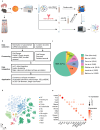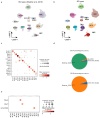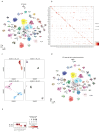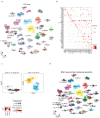This is a preprint.
Comprehensive single-cell atlas of the mouse retina
- PMID: 38328114
- PMCID: PMC10849744
- DOI: 10.1101/2024.01.24.577060
Comprehensive single-cell atlas of the mouse retina
Update in
-
Comprehensive single-cell atlas of the mouse retina.iScience. 2024 May 8;27(6):109916. doi: 10.1016/j.isci.2024.109916. eCollection 2024 Jun 21. iScience. 2024. PMID: 38812536 Free PMC article.
Abstract
Single-cell RNA sequencing (scRNA-seq) has advanced our understanding of cellular heterogeneity at the single-cell resolution by classifying and characterizing cell types in multiple tissues and species. While several mouse retinal scRNA-seq reference datasets have been published, each dataset either has a relatively small number of cells or is focused on specific cell classes, and thus is suboptimal for assessing gene expression patterns across all retina types at the same time. To establish a unified and comprehensive reference for the mouse retina, we first generated the largest retinal scRNA-seq dataset to date, comprising approximately 190,000 single cells from C57BL/6J mouse whole retinas. This dataset was generated through the targeted enrichment of rare population cells via antibody-based magnetic cell sorting. By integrating this new dataset with public datasets, we conducted an integrated analysis to construct the Mouse Retina Cell Atlas (MRCA) for wild-type mice, which encompasses over 330,000 single cells. The MRCA characterizes 12 major classes and 138 cell types. It captured consensus cell type characterization from public datasets and identified additional new cell types. To facilitate the public use of the MRCA, we have deposited it in CELLxGENE, UCSC Cell Browser, and the Broad Single Cell Portal for visualization and gene expression exploration. The comprehensive MRCA serves as an easy-to-use, one-stop data resource for the mouse retina communities.
Conflict of interest statement
Competing interests The authors declare no competing interests.
Figures





Similar articles
-
Comprehensive single-cell atlas of the mouse retina.iScience. 2024 May 8;27(6):109916. doi: 10.1016/j.isci.2024.109916. eCollection 2024 Jun 21. iScience. 2024. PMID: 38812536 Free PMC article.
-
A cell atlas of the chick retina based on single-cell transcriptomics.Elife. 2021 Jan 4;10:e63907. doi: 10.7554/eLife.63907. Elife. 2021. PMID: 33393903 Free PMC article.
-
Cross-species scRNA-seq reveals the cellular landscape of retina and early alterations in type 2 diabetes mice.Genomics. 2023 Jul;115(4):110644. doi: 10.1016/j.ygeno.2023.110644. Epub 2023 Jun 4. Genomics. 2023. PMID: 37279838
-
Single-cell RNA sequencing: A new opportunity for retinal research.Wiley Interdiscip Rev RNA. 2021 Sep;12(5):e1652. doi: 10.1002/wrna.1652. Epub 2021 Mar 22. Wiley Interdiscip Rev RNA. 2021. PMID: 33754496 Review.
-
A Review of Single-Cell RNA-Seq Annotation, Integration, and Cell-Cell Communication.Cells. 2023 Jul 30;12(15):1970. doi: 10.3390/cells12151970. Cells. 2023. PMID: 37566049 Free PMC article. Review.
References
Publication types
Grants and funding
LinkOut - more resources
Full Text Sources
Molecular Biology Databases
